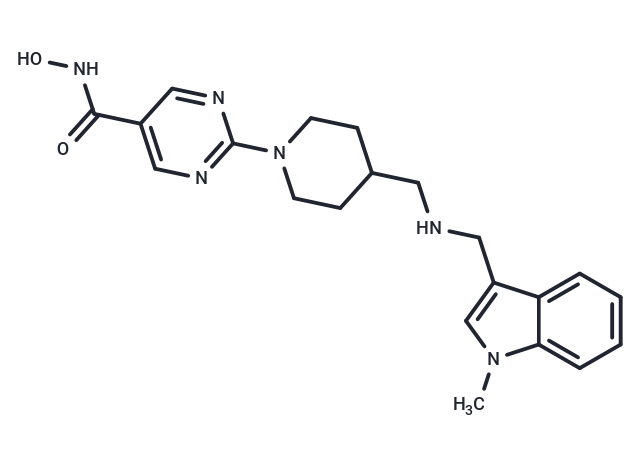Shopping Cart
- Remove All
 Your shopping cart is currently empty
Your shopping cart is currently empty

Quisinostat (JNJ-26481585) (JNJ-26481585) is a novel second-generation HDAC inhibitor with highest potency for HDAC1 with IC50 of 0.11 nM, modest potent to HDACs 2, 4, 10, and 11; greater than 30-fold selectivity against HDACs 3, 5, 8, and 9 and lowest potency to HDACs 6 and 7.

| Pack Size | Price | Availability | Quantity |
|---|---|---|---|
| 1 mg | $54 | In Stock | |
| 2 mg | $78 | In Stock | |
| 5 mg | $126 | In Stock | |
| 10 mg | $225 | In Stock | |
| 25 mg | $349 | In Stock | |
| 50 mg | $450 | In Stock | |
| 100 mg | $638 | In Stock | |
| 1 mL x 10 mM (in DMSO) | $142 | In Stock |
| Description | Quisinostat (JNJ-26481585) (JNJ-26481585) is a novel second-generation HDAC inhibitor with highest potency for HDAC1 with IC50 of 0.11 nM, modest potent to HDACs 2, 4, 10, and 11; greater than 30-fold selectivity against HDACs 3, 5, 8, and 9 and lowest potency to HDACs 6 and 7. |
| Targets&IC50 | HDAC1:0.11 nM |
| In vitro | Quisinostat exerts broad-spectrum antiproliferative activity against a wide panel of cancer cell lines including lung, colon, breast, prostate, and ovarian cell lines at nanomolar concentrations. JNJ-26481585 shows activity toward all HDAC enzymes tested with highest potency in vitro observed toward recombinant HDAC1 (IC50, 0.11±0.03 nM), which is comparable with the potency observed toward HDAC1-immunoprecipitated complexes from tumor cells (IC50, 0.16±0.02 nM). Lowest in vitro potency is observed toward HDAC6, 7 and 9 (IC50, 32.1-119 nM) [1]. |
| In vivo | Quisinostat induces continuous H3 acetylation in tumor tissue in vivo. Quisinostat, a "second-generation" HDAC inhibitor with prolonged pharmacodynamic response in vivo. In agreement with the hypothesis, Quisinostat showed superior efficacy compared with both standard of care agents and first-generation HDAC inhibitors in preClinicalal tumor models. These studies suggest that an HDAC inhibitor with continuous pharmacodynamic activity may show activity in solid tumor malignancies[1]. |
| Alias | JNJ-26481585 |
| Molecular Weight | 394.47 |
| Formula | C21H26N6O2 |
| Cas No. | 875320-29-9 |
| Smiles | Cn1cc(CNCC2CCN(CC2)c2ncc(cn2)C(=O)NO)c2ccccc12 |
| Relative Density. | 1.358g/cm3 |
| Storage | store at low temperature | Powder: -20°C for 3 years | In solvent: -80°C for 1 year | Shipping with blue ice. | |||||||||||||||||||||||||||||||||||
| Solubility Information | DMSO: 79 mg/mL (200.26 mM) Ethanol: < 1 mg/mL (insoluble or slightly soluble) H2O: < 1 mg/mL (insoluble or slightly soluble) | |||||||||||||||||||||||||||||||||||
Solution Preparation Table | ||||||||||||||||||||||||||||||||||||
DMSO
| ||||||||||||||||||||||||||||||||||||

Copyright © 2015-2024 TargetMol Chemicals Inc. All Rights Reserved.